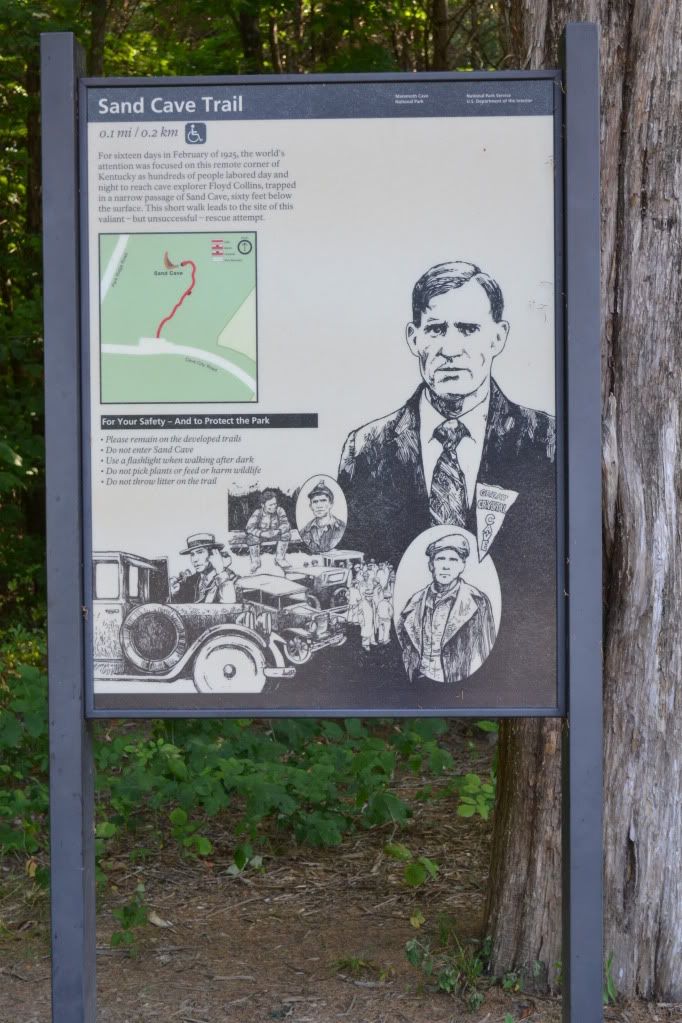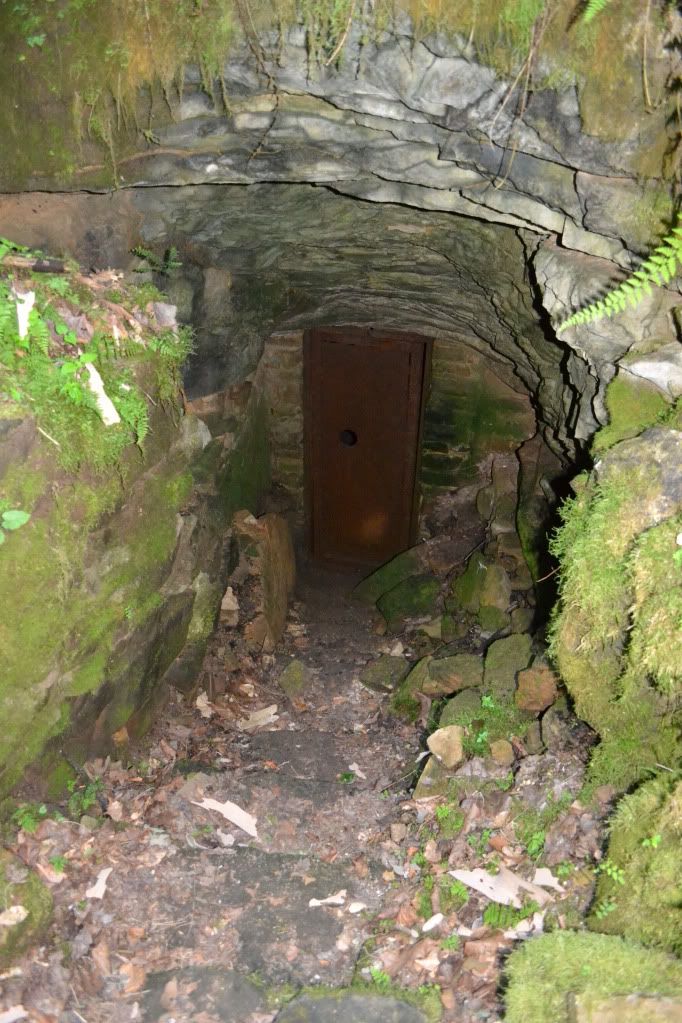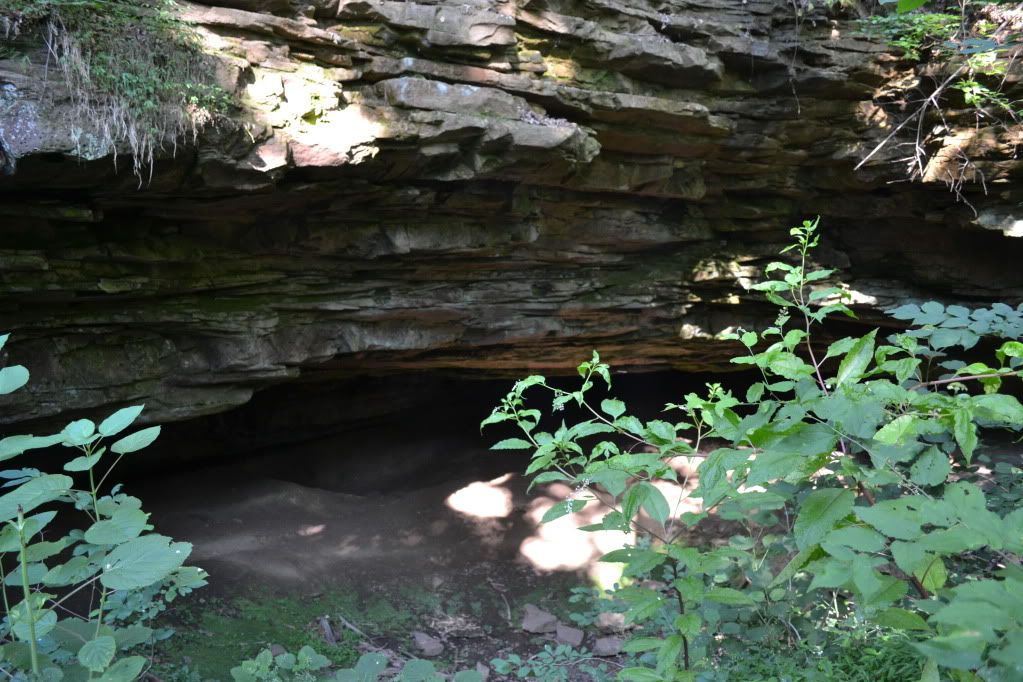The gravel road, in itself, is very unremarkable. It is unmarked as it branches away from Flint Ridge Road, and the gate is posted simply with "Do Not Block the Gate". The temperature registered 106° F as we set off on foot, the car parked well out of the way of the gate. The ice in my nalgene had already melted and the sun beat down cruelly...yup, this was going to be a long, hot walk.
After about a mile and a bit of walking along the level road, two structures emerged in the grassy area in the woods and a broad smile wormed its way across my face. "Well look at that, its the old ticket building and the old Collins' homestead!" This is what I was hoping to see on this particular walk. What brought us out here on the hottest day so far of the year to a rarely visited corner of the Mammoth Cave National Park in Kentucky? One man: Floyd Collins.
First, just a touch of history. West Virginia, Ohio and Kentucky all sit on some pretty significant coal resources. There is a saying that America was built on Pennsylvania Steel and West Virginia Coal. The area of Central Kentucky is not one of these areas. The land is mostly farm country, and as is typical of the limestone belt, its not the best farming. The soil is poor and thin, however it does produce caves and mighty long ones at that. Mammoth Cave had been a tour venture after the War of 1812 with the British and soon several other caves opened for the adventuresome tourist...and as a tourist back then you had to have a sense of adventure in order to travel out there. The roads were in rough shape... accommodations were scant. Eventually a train was put in that would stop at the various caves and a series of grand hotels were constructed at Mammoth. The last cave on the road was Crystal Cave discovered by Floyd Collins. Many of these caves competed bitterly among each other in order to bring in visitors, often a gentleman referred to as a "capper" would hop onto your car on the rugged drive out to Mammoth and inform you that Mammoth had collapsed or was under quarantine (as an interesting side note, Mammoth was used at one time as a ward for people suffering from Consumption, now known as Tuberculosis) and would persuade you to visit some other cave instead. This was the time of the Kentucky Cave Wars.
Floyd and his family operated Crystal Cave, where during the day Floyd and his brothers would give tours, but after hours Floyd would disappear into the mazey depths below. Sometimes for days. Usually alone. This is against the current conventional wisdom of cavers today, but during the Cave Wars this was serious business; if someone finds an entrance to your cave on their property there is nothing to prevent them from exploiting that entrance and making money off of your find.
In February of 1925 Floyd decided to take a gamble on an overhanging sandstone ledge that contained a small, already known cave on the property of Bee Doyle. This also happened to be the first cave one would see on the way from Cave City. They had come to an agreement that the cave would become a commercial venture and that they would split the profits 50/50. Floyd had already done some preliminary work with explosives and had gone in to clear out some rubble when, on his way out, he nudged some loose rock with his foot. Rock shifted and he was unable to go any further. He was trapped. The next morning when Floyd had not returned home, his brother arrived and found him, unable to free him from the cave. More people came, and soon he became a media sensation. Floyd Collins is perhaps the most famous person you have never heard of. There was even a song written about his ordeals underground, and perhaps if your grandparents were around during the 1920's they may remember what happened or they may have the record of the infamous song. To put it in perspective, over a period of 17 days, over 10,000 people crowded into the fields surrounding Sand Cave. Many of the local families put up out-of-towners, for a small fee, and there was money to be made selling food and a mysterious clear liquid that was distilled only by the light of the moon.
During the rescue efforts the passage leading to Floyd collapsed and no one was able to get food to him or report on his condition. Two mining and well companies were brought in to compete for digging a parallel shaft in attempts to dig in below him to extract Floyd and return him to the light of day. After some misfortunes with that endevour, they were finally able to dig a shaft in and they found his lifeless body on the seventeenth day of his entrapment. Floyd lost his battle with Sand Cave. The visitors left, the hillside resembling a field after trench warfare and silence returned to the Kentucky hills. His body was finally removed by a group of coal miners and he was later buried in Crystal Cave for a time, and soon after Mammoth Cave was adopted as a National Park, eventually acquiring the property that contained Sand Cave and after many decades, eventually the Collins' Homestead and Crystal Cave.
I had become familiar with the story of Floyd, as many cavers have, since his is a cautionary tale of caving alone and the mishaps that can happen. I even read the book Trapped! by Robert Murray and Roger Brucker which gives a fairly detailed account of the events before, during and after Floyd's demise. I learned of "Skeets" Miller, a reporter, who had brass balls and perhaps spent the largest amount of time with Floyd during his entrapment, and of the fact that people had failed to notice a small side fissure that led down to a space under Floyd where the rock that trapped his leg could have been lifted and Floyd would have been rescued. And perhaps the most appalling thing was the large amount of food tins stuffed into cracks of the passage and were never passed through the collapse to the weakening caver starving below.


Upon arrival at the Collin's Homestead we first had to check out the ticket building. Though the windows were shuttered the doors were wide open. I poked into the ticketing office and quickly made a retreat...something in there smelled dead. Very very dead. In the dim light filtering through there appeared to be a couple odd looking bits of unidentifiable equipment and an old mattress on the floor. Further around the other portion of the building were long out of use toilets. Next we pressed our noses against the window glass of the house itself. It is hard to imagine that a house of this size, only three or four rooms, once held 10 inhabitants.
Between the house and the ticket building was a well worn trail leading down a hill. This was definitely the trail down to the entrance of Crystal Cave. The handrails are now gone, only a few of the supporting uprights exist now. Th trail rounds the corner, and something very out of place confronts you...a red warning sign explaining that the cave is not to be entered. We were not going to enter the cave however. Aside from trespassing, it would be fruitless since we didn't bring any gear. The path continues down steps through some very beautiful ferns and columbine until we saw the quiet open mouth of the cave. A few feet beyond where it starts to get dark is a steel door that halts further progress into the cave.
Amazing to think that in the not so distant past, this was the starting point for another epic journey that has been largely forgotten except by the caving community. For, through that steel gated portal, many generations of cavers followed Floyd down the Valley of Decision to the Devil's Kitchen, left though the Gypsum Route to the Scotchman's Trap to where the cave REALLY begins, eventually leading through the bowels of Flint Ridge to the surrounding caves an eventually connecting to Mammoth Cave, making the Mammoth Cave-Flint Ridge-Joppa Ridge System the longest cave in the world.

Floyd's Body was eventually laid to rest at the Flint Ridge Cemetery after having been on display in the cave he discovered, kidnapped from the cave he discovered and found tossed over a hill, re-interred in the cave and later put to rest next to his father and birth mother. The headstone is remarkable for several reasons: the granite headstone is the original that was placed in the cave when he was buried, and secondly because it is lacking a date of death (post comments with what you think might be the reason for this). When visiting the grave it has become customary for cavers to leave behind a small token of some sort. I placed a Snickers bar on his grave which I am sure melted immediately in the 100° F + weather. Just a little something for you there Floyd.
After visiting with Floyd we drove out to Sand Cave which is right at the Entrance to the Park. The walk is wheelchair accessible via a boardwalk and is a pleasant walk through the wood. The walk ends at a platform situated above the solemn and damp entrance to Sand Cave. It is here that men laboured around the clock to save Floyd from the narrow passages below. A faint path leads off the end of the boardwalk, over the upper edge of the entrance and then down natural steps to the entrance (this is off the official path, so stepping off is you assuming the risk of doing so). My price of admission was the garbage I picked up along the way. I took a moment standing in the summer light, the sound of water dripping from a hidden passage under the ledge above.
I would have stayed longer, but my scheduled tour for the Violet City Lantern Tour was about to begin. It would prove to be one the the highlights of my trip to Mammoth Cave, so if you ever get the chance, I highly recommend the tour. I also recommend taking the time to visit Sand Cave and the Flint Ridge Cemetery. They are both very accessible pieces of history that has been largely forgotten by modern times, but back in the mid to late 1920's this was a story that was known well throughout the United States.
The song, performed by Vernon Dalhart is "The Death of Floyd Collins", is another piece of Americana that is not to be missed.
Please visit the website for more information about Mammoth Cave National Park, which is open year round for cavern tours. Keep in mind that the tour schedule varies by season and during the busier times of the year tours can fill up very quickly, so online reservations are recommended. Solid and comfortable footwear is highly recommended as well as a sweatshirt or hoodie. Walking to the Historic Entrance is surprisingly cool and windy...afterall, there are over 390 miles mapped of the known cave, that's a of air that moves when the weather changes. Prices vary depending upon tours, but incredibly reasonable in comparison to the privately owned commercial caves.











